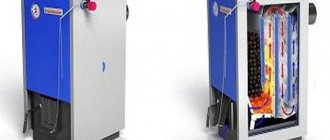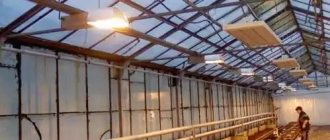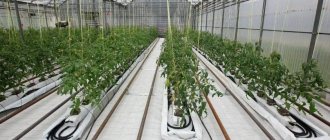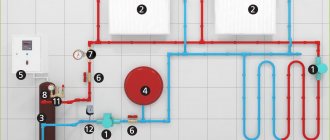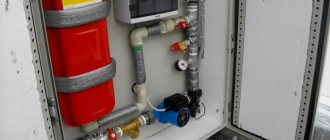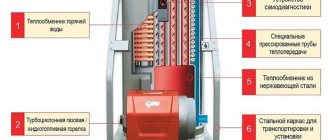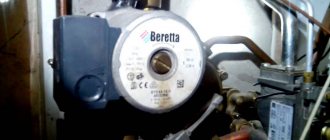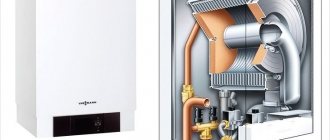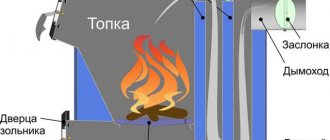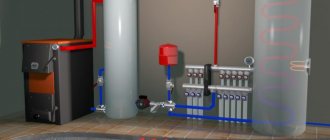This article presents photos and videos of the company GRV (Gruzdev boilers)
Greenhouses are actively used for growing cucumbers, tomatoes, lettuce and other crops year-round. In the greenhouse, with the help of heating equipment, boilers and heat generators, air and soil are heated to the required levels. Temperature directly affects the development of vegetable crops as well as watering, sunlight and nutrients. In addition, the risk of pests is reduced, which affects the quality of the crop in the end, and the presence of diseases with proper disinfection of the soil after building a greenhouse, the risk of diseases is greatly reduced.
There are special requirements for temperature conditions in nurseries; for them we recommend combined boilers that heat air and water. Hot water is used to heat the soil and the irrigation system, and hot air is used to heat and ventilate the greenhouse.
Rice. 1 Photos of GRV heat generators for shipment for heating greenhouses
The GRV solid fuel heat generator was originally designed for heating greenhouses, but has found a very wide range of applications. Over the past two heating seasons, we have improved aerodynamics and increased the efficiency of the unit. Due to its high properties, the heat generator is also used for drying, and some greenhouse farms use it all year round. In summer for drying chambers, in winter for heating.
Heating can be: with manual fuel loading and automatic
Rice. 2 For heating in manual mode, a slab is suitable. GRV heat generators are adapted for this
For heating: air heating, combined heating (we heat air and soil), water heating registers.
In order to heat a greenhouse with an area of 500 sq.m. you will need:
1. Concrete platform for placing the heat generator under its base
2. A set of air ducts according to diagram No. 1 or diagram No. 2 (see below)
3. Perforated mounting tape for mounting air ducts or fastening according to the drawing (see below)
4. If there is no 380V voltage on the site, then you should purchase a frequency converter (you can order from our company) it will convert from 220V to 380V.
5. Next, the installation of air ducts and chimney installation is carried out
This system is guaranteed to work only with GRV heat generators, which already operate more than 40 greenhouses throughout Russia. TG and “pyrolysis” heat generators are not intended for heating greenhouses.
Particular attention is paid to the design of the heat generator, which should ensure operation with the same efficiency as a hot water boiler
Rice. 3 Decoupling unit. The so-called “pants” are needed to distribute air on the left and right sides
Rice. 4 Different colors indicate different elements of the duct system
Please note in diagram No. 1 that the fuel loading neck and the firebox door are located outside the greenhouse. Firstly, this allows you not to enter the greenhouse at night, i.e. Close it with a lock, do not let it get too hot. The firebox and ignition are carried out outside the greenhouse. You can make a light shed or make a boiler room from lightweight structures. It is important to occupy the minimum usable area of the greenhouse. Every square meter of a greenhouse should be profitable.
Rice. 5 Installation of air ducts in a wooden greenhouse
To secure the air ducts, you should use perforated mounting tape, which can withstand high tensile loads and is easily mounted to the greenhouse frame
Rice. 6 Mounting tape for air ducts
When choosing a layout of air ducts, you should contact a specialist at GRV; depending on the design of the greenhouse and the type of plants, the air ducts should be placed differently and the selection of fans should also be chosen correctly
Rice. 7 Installation diagram of the GRV heat generator, which runs on coal and wood. Fuel can be loaded from the street, this reduces the number of unnecessary visits to the greenhouse
Rice. 8 Photo taken during operation of a 400 kW heat generator. Most of the smoke is steam, since usually freshly cut firewood and slabs with high humidity
The heat generator can be supplemented with automatic fuel supply, a vortex burner using pellets, husks or sawdust.
Rice. 9 Heat generators are long, which allows the use of any slab or wood waste for heating the greenhouse
Rice. 10 For stability, the heat generator is turned over on its side
Rice. 11 Vortex burners on pellets for heat generators and boilers. Installed inside the greenhouse
Using the example of objects with greenhouses, an automatic fuel supply system reduces labor costs by 2-4 times. One person is able to control the heating of 5 operating units at once, this is more than 10,000 sq.m. greenhouses
Rice. 12 For particularly large heat generators, the chimney is installed inside the mast
A very detailed video on the installation and design of the heat generator is presented below. This object is located in the Krasnodar region. A wood-fired heat generator with a power of 400 kW heats a greenhouse area of 2000 sq.m. All types of crops are grown in the greenhouse. Type of fuel: firewood, slab. An extension has been organized for the heat generator, which is combined with the greenhouse. But a roof made of non-combustible material is installed above the heat generator. We have selected the most minimal radial fans to reduce energy costs. In a greenhouse, which is very important, the humidity process is optimized; plants are less susceptible to diseases than with high humidity. Since the GRV heat generator gives a large temperature delta, it is easy to ventilate the greenhouse in any weather outside, additional air intake from the street is possible, and not cold but heated air enters the greenhouse
Fully automatic greenhouse heating with air heat generator GRV
Air heating using GRV heat generators allows you to effectively maintain the microclimate in the greenhouse in accordance with all requirements for temperature and humidity in the greenhouse. GRV heat generators for greenhouses are designed with a power reserve and maximum efficiency for these devices. Automatic piston fuel supply has greater force than auger fuel supply, does not fail when foreign objects enter, and is easy to maintain.
To control the temperature, the heat generator comes complete with a control panel based on the domestic programmable controller PR200 with wide functionality and the possibility of additional expansions at the request of the customer.
Rice. 13 Scheme of a greenhouse and air heating with fully automatic operation
Video of the operation of an automatic heat generator for air heating
Rice. 14 Top view plus specification of elements for heating a greenhouse of 500 sq.m.
Rice. 15 This is the diagram for installing a heat generator for heating a greenhouse. Its location should be close to the exit from the greenhouse. Due to the large bunker, loading is carried out once a day or once every two days, depending on the outside temperature
As mentioned above, air heating is fast, efficient and inexpensive. But there are objects in which installing air heating is problematic, for example, many free-standing greenhouses, or a greenhouse with an area of 10 thousand square meters. In this case, we install water heating boilers with automatic or manual fuel supply.
Rice. 16 Universal hot water boiler for heating an industrial greenhouse. The boiler is installed directly
Heating of a greenhouse with an area of 1000 sq.m. usually carried out by a boiler of 200 kW per hour.
- Heating can be either air or water using a network of registers and an assembly manifold.
- If there are several greenhouses, preference should be given to the automatic GRV series (they come with a universal firebox)
- The hot water boiler is installed in a greenhouse or boiler room. To install the boiler in a greenhouse, you should use a special “vestibule”; if you heat it manually with wood or coal, opening the doors is inevitable
- Mandatory reserve for the power of the boiler and the heating system itself
- The boiler must be more powerful than the heating system for firing at night in the winter when there is no heat source in the form of the sun
Rice. 16 Heating a greenhouse 1000 sq.m. hot water boiler
It is important that when choosing a boiler, the size of the firebox is taken into account. In winter, there is a lot of worries in the greenhouse, and it is not always possible to burn with chopped wood.
Rice. 17 Piping unit for two heating of two greenhouses with an area of 2000 sq.m. at an existing facility
Rice. 18 Scheme of hot water heating of a greenhouse using air heaters. This greenhouse has an area of 600 sq.m. To cut off the cold, registers are laid on the sides of the greenhouse in two branches of 76 mm pipe. The heaters are powered from registers, thus saving material and reducing the cost of the main pump. The uniformity of the flow is ensured by installing a small capacity pump on each heater
Rice. 19 On the previous slide, a scheme for hot water heating of a greenhouse can be developed; a universal boiler GRV 150 is installed in the boiler room of the greenhouse, which runs on pellets and wood. A firebox with a length of more than 1500 mm provides the ability to dispose of solid waste
Boiler for heating a greenhouse
The greenhouse industry in our country is actively reviving , powerful complexes and numerous private farms are appearing that supply quality products to our tables.
The specific climate of the country forces us
to take the heating of greenhouses and greenhouses seriously a soil and air heating system must be equipped to maintain optimal temperatures. For this, it is worth choosing an economical boiler with high efficiency, which will minimize the cost of growing agricultural products in the winter. Don’t forget about modern technologies, such as gsm modules , which will allow you to control the operation of heating equipment online using a smartphone .
Bubafonya
Making previous models with your own hands is quite difficult and almost impossible. As for the Bubafoni stove, the situation here is completely different. Having knowledge and skills in plumbing and welding, you can easily make a unit at home. It is home-made installations that are most often used for heating greenhouses and other auxiliary buildings that are located on a personal plot.
To make a boiler for a greenhouse with your own hands, you use various materials that can be found on the site or purchased in a store. An old gas cylinder or steel barrel is ideal for creating an equipment housing. It contains an ash pan and a fuel chamber with a door through which fuel is loaded. The design includes a metal pancake that ensures smoldering of firewood.
Important! The advantage of Bubafoni is that, thanks to its design and operating principle, it is able to function on one bookmark for a long time.
Installing equipment in a greenhouse is easy
What kind of boiler is needed for a greenhouse?
The classic water heating system is perfect for a greenhouse. It allows you to simultaneously heat the soil and air. To do this, pipes are laid in the ground, and heating radiators are installed outside. The specificity of the operation of this system is the large difference in coolant temperature at the inlet and outlet. After circulation in the system, the water can cool down to 45-50 degrees! Not all heating equipment can cope with such a difference; the most correct solution would be to install a condensing gas boiler. This technique has the following advantages :
- Low fuel cost;
- High equipment efficiency;
- Use of steam energy;
- Compact dimensions;
- Simple controls.
A condition for efficient operation of condensing gas boilers is a low return temperature. Steam condensation occurs at 50ºС and according to this indicator, the greenhouse water heating system fully complies with the requirements of equipment manufacturers. Under such conditions, efficiency reaches 107-109% , which ensures economical heating of farm greenhouses.
High technologies do not always contribute to high quality greenhouse heating. Long-burning solid fuel boilers and pyrolysis models are popular among fans of autonomous heating due to the availability of fuel and its environmental friendliness. It is not recommended to use this technique for heating a greenhouse, since the low temperature of the coolant in the return will cause condensation to form on the internal walls of the boiler and the heat exchanger. When mixed with combustion products, aggressive solutions are formed that destroy the walls of expensive equipment.
In the absence of gas heating, the best choice would be a classic solid fuel boiler . He will cope with the task perfectly, but will require increased attention.
If you have already purchased a pyrolysis boiler or a solid fuel long-burning model, then you will need to consider a system for heating the return to a temperature above 50ºС .
Solid fuel boiler for greenhouse
Solid fuel boilers for greenhouses are relevant today in those parts of Russia where, for one reason or another, central gas supply has not yet reached. Long-burning solid fuel heating boilers for greenhouses are characterized by increased efficiency due to the use of modern technologies in their design and production, as well as the use of the highest quality materials. They provide fast ignition of fuel, its long-lasting combustion, as well as excellent heat transfer. Solid fuel boilers for greenhouses also guarantee high-quality, environmentally friendly combustion of fuel, which makes their use in heating systems convenient and comfortable. Boilers for greenhouses using long-burning wood are universal. In greenhouse boilers you can use any solid fuel: firewood, wood chips, briquettes and pellets. The type of fuel can only affect the heating time of the room and the heating of water in the DHW circuit. To achieve maximum heating performance, we recommend using oak or birch firewood.
The solid fuel boiler for a greenhouse is a complex welded structure made of high-strength heat-resistant steel that has undergone special anti-corrosion treatment.
Heating a greenhouse with a solid fuel boiler has proven itself on the positive side even in the most difficult operating conditions:
- Saving money thanks to fuel savings (1 tab 7 - 18 hours)
- High thermal efficiency due to improved heat exchanger and good insulation
- Eco-friendly boilers. Very low emissions of CO and other harmful substances
- Large doors and elevators for convenient fuel loading and convenient maintenance
- Automatic regulator allows you to regulate the combustion process
- The design of the water jacket can withstand pressure up to 10 atm. (at a norm of 2 atm.), which guarantees the safe operation of the solid fuel boiler.
Advantages of long-burning solid fuel boilers for greenhouses:
- a wide range of household line of long-burning pyrolysis solid fuel boilers with power from 10 kW - 50 kW, semi-industrial line from 50 - 100 kW and industrial line of solid fuel boilers with power from 150 kW - 1 MW;
- saving money due to fuel savings (1 tab 7 - 18 hours);
- high thermal efficiency due to an improved heat exchanger and good insulation;
- environmentally friendly boilers. Very low emissions of CO and other harmful substances;
- large doors and elevators for convenient fuel loading and convenient maintenance;
- automatic regulator allows you to regulate the combustion process;
- The water jacket design can withstand pressure up to 10 atm. (at a norm of 2 atm.), which guarantees safe long-term operation.
The unique, durable design of the water jacket of the solid fuel greenhouse boiler is capable of withstanding a pressure of 10 atmospheres, which ensures complete safety of operation.
Boilers for greenhouses using solid fuel with a heating output of 100 kW are suitable for heating greenhouses with an area of 500 m2 or more. The use of the pyrolysis combustion method ensures high productivity of wood-burning boilers with low fuel consumption (filling 1-2 times a day). The simplicity and ease of operation of this type of boiler makes it possible to light the fire even without special skills. In addition, the installation and use of a long-burning boiler does not require the organization of a special room.
The boiler for a wood-burning greenhouse is very easy to use. Thanks to its design, it is able to work from the first stack of firewood for 12 hours! It's all about the gas that is formed in the combustion chamber. In conventional boilers, this gas goes directly into the pipe outside and is not used in any way. And in wood-fired pyrolysis boilers, gas and heated air from the combustion chamber enters the secondary combustion chamber. It is there that a high temperature is formed and the water of the heating system is heated. Therefore, the efficiency of a long-burning boiler is 87%!
Where to install the heating boiler?
For large greenhouses, you can build a separate boiler room ; in medium-sized greenhouses, it is better to install heating equipment directly at the entrance to the room . Is it necessary to fence the boiler? This is not necessary, especially in the case of using gas heating equipment. If preference is given to a solid fuel boiler, then you should make sure that there is a supply of dry fuel next to the boiler. If the air humidity in the greenhouse is high, it is worth making a separate room for storing fuel.
How to choose a boiler for greenhouses: advice from experienced farmers
A boiler for greenhouses is the equipment that will allow you to get a good harvest even in severe frosts. Everyone knows how much vegetables cost in winter, so bringing your own vegetables during this period is a very profitable solution. But every vegetable grower who decides to start heating a greenhouse may face the difficulty of choosing a boiler, because there are several varieties on the market. Which one should you choose for this or that site? Or maybe it would be easier and cheaper to make it yourself from scrap materials?
Boiler options for greenhouses
At the moment, the following boilers for greenhouses are widely used:
- wood;
- combined (wood-coal);
- pellet;
- gas;
- electric.
Conventionally, they are classified into two more subspecies. Solid fuel boilers are the first three types above. Long-burning boilers are included in a separate category, since the principle of their operation is not based on the combustion of materials, but on their smoldering, for which a system of controlled oxygen (air) supply is used. They are the most effective and economical, but are quite expensive.
The simplest heating boilers for greenhouses are gas and electric. However, it is impossible to call them economical and profitable in the current situation. Gas and electricity are already too expensive for heating, and further price increases are expected in the future. Therefore, such boilers are used only for emergencies, when other heating options are simply unavailable for some reason.
You can cook a wood-burning boiler yourself, but it will turn out to be a banal potbelly stove. Its advantages are low cost and efficiency, but its disadvantages are the inability to regulate the temperature, the need to constantly add fuel (wood or coal), as well as uneven heating of the greenhouse area. Their use will be justified only if we are talking about a polycarbonate or glass greenhouse with steam heating (or where the pipes are laid in the ground at a depth of about 50 centimeters). And such a boiler for heating a greenhouse is suitable only for small areas. If the greenhouse occupies more than 50 square meters, then several “bourgeois” will be required. Keeping track of them is extremely difficult and troublesome.
But there is also a very big advantage for wood-burning boilers and long-burning boilers for solid fuel greenhouses. The product of their waste is ash and ash, which are extremely useful “ingredients” for growing any vegetable and fruit crops. And in the case of beets, for example, ashes allow you to get rid of any insect pests and thereby save a considerable amount on the purchase of agrochemicals (pesticides and mineral fertilizers). For a vegetable grower, this is not the least advantage.
Types of boilers for heating greenhouses
Reliability, safety, efficiency, aesthetics - depending on the model of heating equipment, the listed characteristics are combined in different ratios. Most often, a water heating system is installed in the greenhouse, which means that the choice must be made in favor of solid fuel varieties. Regardless of the type of fuel, the device for heating seedlings uses it quite sparingly.
However, this is not a reason to let down your guard.
In order not to regret wasted money, it is necessary to understand the functional differences between different types of fuel:
- Classic boiler with firebox;
- Pyrolysis with a smoldering chamber;
- Carbonic;
- Coal-wood;
- Pellet;
- Gas.
In the technical description of the product you can always find data reflecting the “gluttony” of a solid fuel boiler. The lower the specified value, the cheaper the operation will be. It must be remembered that large greenhouses require a more productive unit. An unjustified desire to save money will result in prolonged cold.
How to choose a solid fuel boiler, what do you need to know about the design features and what precautions must be taken? You can learn about this from the article: https://homeli.ru/stroitelstvo-doma/inzhenernye-sistemy/otoplenie/kotly-na-tverdom-toplive
In the case where an electric heat supply system is used on the site, it is necessary to make a preliminary calculation of the required power. Based on the data obtained, an electric boiler is selected.
The main thing is not to make a mistake with the size of the area that needs to be heated. It is not recommended to take a boiler with a large or not very large reserve. All this will only provoke unjustified spending.
When choosing heating equipment for greenhouses, you need to pay attention to three factors. It all starts with the size of the structure. If solid fuel models are suitable for a small greenhouse, then electric varieties are suitable for large ones. In addition, you should remember about the heat supply system present in the greenhouse and the characteristics of the planted crops.
Which boiler to choose for a greenhouse
When choosing a boiler for heating greenhouses, you need to take into account both the area of the heated room and your financial capabilities. Ideal - long burning, but they cost an average of 100 thousand rubles. But their consumption is 2 styling for 24 hours. In large greenhouses, they completely pay for themselves in just 1-2 seasons (if the firewood or coal is purchased). In small ones, with an area of about 15-20 square meters, the payback will stretch over almost 10 seasons.
For the latter option, simple solid fuel heating boilers or those that run on gas would be ideal. The efficiency of the system will be significantly higher if it is supplemented with a pump for pumping water through pipes. This, by the way, will ensure uniform heating of the heated room.
An electric boiler, as practice shows, is a pointless waste of money. They are inefficient, use too much electricity, and only increase the temperature at the top of the greenhouse. The volume near the ground remains cold, which leads to freezing of plants.
Combined long-burning boilers are classified as industrial boilers.
They should be purchased only if the greenhouse is over 100 square meters and crops that react extremely sharply to changes in microclimate are grown in it.
These are, for example, bell peppers, strawberries, strawberries, raspberries, eggplants, carrots, potatoes. They cost accordingly - from 200 thousand rubles. But the savings are huge! And boilers of this type also operate on liquid fuel (meaning recycled oil, fuel oil, oil industry waste).
A few words need to be said about the pyrolysis boiler, which is conventionally a derivative of long-burning solid fuel. Its operating principle is based on burning wood gas. It has very high heat transfer, since a flame is supplied through the nozzle as if from an autogen, thereby quickly heating the water tank. The heat can be dissipated into a steam heating system or by a fan through a radiator. Such a boiler is both productive and economical, but it occupies quite a large space (including in height). Not suitable for small greenhouses, as they can burn plants. The landing distance from the boiler is at least 50 centimeters.
Emergency heating boilers
An experienced vegetable grower always has different types of heating boilers at his disposal, since one of them may turn off due to an interruption in gas supply, electricity, or simply break down. So, for emergency situations, electric ones are ideal, where the heating element is heated, and the heat is dissipated by a cooler. But they should be supplemented with an autonomous generator.
The most ordinary wood-burning stove is also an excellent solution for emergency heating of the greenhouse volume. But its construction should be done in advance. Smoke removal can be done in several ways. But we must not forget that vaporous gas is not harmful to plants and reduces thermal conductivity. Thanks to this, the cooling rate of the greenhouse will be significantly reduced.
Every vegetable grower could use a mobile pellet boiler. It is quite easy to transport, but it is useful for burning any solid fuel, including corn cobs. At the same time, heating occurs quickly and evenly. The only drawback is the need to have a chimney, and in strong winds it will blow in from the outside. That is, a large amount of smoke will enter the greenhouse. Plus, pellet boilers are demanding to maintain. They quickly accumulate moisture, which can only be removed mechanically. In any case, this is an excellent option for emergency heating, in which fuel can even be combined (for example, kindling with wood, maintaining temperature with coal or peat).
Boiler for heating a greenhouse: wood, electricity and gas
Now we will look at the options for boilers for heating a greenhouse and see which one to choose. This can be a wood-burning, gas or electric boiler.
Currently, a healthy lifestyle is being massively popularized. A person’s physical condition depends, first of all, on what foods he consumes. Therefore, today more and more people are trying to eat healthy.
As you know, vegetables and fruits that lie on store shelves are stuffed with nitrates and other poisons, so many decide to grow their own food and resort to using greenhouses. In order for plants to grow well, it is necessary to maintain a comfortable temperature in the greenhouse, especially in winter when the air temperature is low.
Moreover, for the normal growth of your vegetation, it is important to heat not only the air, but also the ground. If this is not done, the grown products will simply die. To prevent this from happening, it is worth acquiring a boiler for heating greenhouses. This is the equipment that will act as a source for maintaining the desired temperature in your “winter garden.”
The main factors that influence the choice of heating method for greenhouses are cost and temperature stability. Therefore, it is important to choose a good heating unit.
Boilers for greenhouses are:
- solid fuel;
- gas;
- electric.
Solid fuel boilers
Today, wood heating units are the most common and affordable. This is due to their high productivity and efficiency, because the fuel for them is ordinary firewood, waste from furniture and woodworking industries, wood trimmings, branches cut from trees and even dry garbage.
You can choose among the following types of solid fuel boilers:
- wood (conventional or pyrolysis);
- coal and wood;
- pellet (work on compressed pellets of wood, seeds, straw, and various waste).
Solid fuel boilers for greenhouses have many advantages:
- environmental friendliness;
- cheapness;
- availability;
- safety;
- aesthetics;
- non-explosive.
The efficiency of such boilers is in the range of 75–90%.
Using solid fuel boilers as a method of heating the greenhouse, you can be content with fresh vegetables and fruits all year round.
However, such devices also have some disadvantages:
- To store such devices, you need a “solid” size area.
- It is necessary to prepare fuel in advance.
- They require regular maintenance (cleaning the boiler firebox from ash, adding fuel).
How to make a boiler for a greenhouse with your own hands
If you want to save money and do not want to buy a ready-made unit, you can make a solid fuel boiler for heating a greenhouse with your own hands.
To do this you need to perform a number of actions:
- Get a barrel with a volume of 3 cubic meters.
- Using a drill, drill three holes in it, which will serve for the outlet of the chimney, drain and expansion tank.
- At the next stage, a 5 m high chimney is attached to the barrel. This device will be responsible for removing carbon dioxide from the greenhouse.
- An expansion tank must be attached to the top of the barrel; you can weld it yourself.
- Then you need to lay a heating system throughout the greenhouse; the best and cheapest way is plastic pipes.
- Using a special soldering iron, you need to weld the pipes together.
Plastic does not rust or corrode and is able to remain operational despite temperature changes and high humidity.
ADDITIONAL SLIDES
Greenhouse heating schemes from GRV
Rice. 20 Heat generator GRV 500 in the amount of 4 pieces for heating an industrial greenhouse of 9600 sq.m. Four heat generators operate on solid fuel, with the ability to connect a gas burner. Heat generators are installed directly in the greenhouse. No capital investments are required in the boiler room. Manual operation requires two people at night. Only one person operates the burners.
Rice. 21 Heating a greenhouse with an area of 3000 sq.m. A solid fuel heat generator with a capacity of 600 kW will cope with the task. Can be supplemented with an automatic burner
Rice. 22 Heating project for a greenhouse with low arches. Previously, it was problematic to provide heating in greenhouses of this configuration. The proposed heating scheme from GRV makes it possible to provide heat to greenhouses with low arches with minimal investment.
Rice. 23 Boiler room design for a heat generator. Comfortable, lightweight design. It is installed at the end of the greenhouse, does not take up useful space in the greenhouse, and provides space for storing fuel for a two-day supply. Cooling of the greenhouse is minimized.
Rice. 24 Air heating of a greenhouse with an area of 600 sq.m. based on the automatic heat generator GRV 120.
Rice. 25 Combined heating system, when both the ground and the air are heated from one heating equipment. Optimal for growing cucumbers. You can ventilate the greenhouse even at -30*C by passing cold air through the heat generator, it heats up and the clean heated air is transferred to the greenhouse
Video of boiler piping for two greenhouses
Gas devices
Gas boilers for greenhouses are a good option. They ensure that the greenhouse operates smoothly and is heated at a level suitable for the vegetation. The automation of the boiler ensures its autonomous operation, while human participation in this case is limited.
Using gas heating, you can heat the greenhouse in one of the following ways: air, water, infrared.
Infrared gas heater for greenhouse
Most often, infrared gas heaters are installed on the roof. This is due to the fact that gas infrared heating of a greenhouse in winter has one important advantage: the soil is heated first, and only after it the air.
The disadvantage of such heating is the need to install ventilation to remove combustion products.
The second option is to heat the greenhouse with a gas boiler combined with a water system.
Gas boiler for greenhouse
To put this heating method into effect, it is necessary to install smooth pipes with a diameter of no more than 40 mm over the entire area. They need to be laid along each bed 20-30 cm above ground level. The following types of wiring are allowed:
- The supply line is along one wall, the return line is near the other. They are connected to each other by transverse pipes running between the beds.
- The supply and return lines are laid along one wall. Each heating pipe runs along one bed and returns past another.
- The pipe is laid in a snake pattern over the entire area of the greenhouse, forming a single heating circuit.
Shut-off valves must be installed on each branch so that it is possible to turn off the circuit in the event that there is no vegetation in the greenhouse.
In a greenhouse heating system using a gas boiler, the main advantages can be noted:
- autonomous operation of the device;
- ease and speed of boiler maintenance;
- high efficiency.
- It is difficult to supply gas to the greenhouse: you need to call a special service.
- High cost of gas tariffs, especially in the summer.
Methods of heating a greenhouse with wood
Today, despite the development of modern technologies, wood heating is still in demand among consumers. Modern systems have been improved compared to the potbelly stoves of the last century. They have become more universal and do not require round-the-clock monitoring, as before. Such equipment can be made in several versions:
Central wood stove
Buleryan stove.
The simplest and most commonly used method of heating a greenhouse. The structure can be made with your own hands from bricks (can be used) or metal sheets connected by welding. It is necessary to install a chimney in the stove that will exit through the roof or wall of the greenhouse. In this case, the heat sources will be the stove itself and the chimney through which the heated smoke comes out.
The main disadvantage of such a stove is that the heat is located in one place - around the stove itself. And the farther from it, the colder the air in the greenhouse will be. While at the heat source itself the air can reach a temperature that can have a detrimental effect on vegetation.
Wood stove in a greenhouse.
Advice! In order to distribute warm air throughout the greenhouse, it is enough to install a fan near the stove, which will distribute warm air from the stove to the rest of the heated room.
It should be noted that when using a central wood-burning stove, the air humidity in the greenhouse itself sharply decreases, this causes the soil to quickly dry out, and the plants may begin to wither. To avoid this, you need to install a large container of water in the greenhouse.
Another disadvantage of using a central stove is the inability to store a large supply of solid fuel for it directly in the greenhouse. Firewood will occupy a significant area and be an additional source of harmful insects. If you keep the fuel outside, then the constant opening and closing of the greenhouse doors will allow warm air to escape to the street.
Stove with a horizontal chimney along the greenhouse
The horizontal chimney additionally heats the air
The chimney should be laid along the walls or under the ceiling itself so that a person can avoid accidental burns. This design promotes uniform distribution of warm air throughout the entire area of the greenhouse. But there is one thing!
Important! In such systems, soot quickly accumulates and in order to avoid fires, the pipes must be cleaned frequently, which is quite difficult if they are horizontal.
To solve these problems, changes must be made to the system design. It is necessary to install the stove in a pit, and pass the chimney pipe through the greenhouse at an angle or under a small layer of earth. In this case, the design feature of the heating will allow the soil to be heated in addition to the air.
Wood burning stove with water heating
External furnace and internal water circuit
The most effective way to heat a greenhouse with wood is a stove or boiler with a water system, which avoids the above difficulties. At the same time, it becomes possible to heat evenly all areas of the greenhouse without exception.
The stove is installed outside or inside the room, or in a separate vestibule. From it, a closed circuit of pipes is laid through the entire greenhouse, through which the coolant circulates, as in a house.
If the equipment is installed outside or in a separate vestibule, then firewood can be stored there. Precious heat is retained more, since there is no need to constantly open the greenhouse door to add fuel. In addition, there are no carbon monoxide emissions and the habitat of harmful insects is reduced.
Note! When the stove stops heating, water heating can retain heat in the greenhouse for a relatively long time.
If the greenhouse has a concrete floor, you can run pipes underneath it. This will create a beneficial effect, because the soil itself will warm up, which will have a positive effect on the plants. As you know, the temperature of the earth, not the surrounding air, is most important for plants.
Advice! When organizing a heating system for a greenhouse, to achieve maximum results, many people bury pipes directly into the ground.
The only disadvantage of water heating is the complexity of installation, which is compensated by the efficiency and reliability of the system.
Electric boilers
Electric boilers are easy to use and accessible wherever power lines are installed. But if you want to purchase an electric boiler to heat the greenhouse, then you should understand that such equipment is quite expensive, and its use is not always appropriate or justified. In addition, now there are often blackouts, and during such a period your vegetation may simply die.
However, such heating, calculated per unit of heat, is the most expensive. In addition, to connect an electric boiler, a separate line is required, and often not 220 V, but 380 V, and wiring such a line is a complex, time-consuming and expensive process, and besides, this option is not possible everywhere due to the lack of technical capabilities.
The advantages and disadvantages of an electric boiler for greenhouses are as follows.
| Advantages | Flaws |
| Low price of equipment. | The need for a permanent connection to the power grid. |
| Availability. Can be purchased at any large hardware store. | High energy costs. On average, electricity bills when using such a heat source increase by 10-20%. |
| Convenient control system, so there are no difficulties with operation. | |
| No combustion products, no need to install a chimney. | |
| Minimal maintenance. The electric heating element does not need to be cleaned of soot or dirt, as, for example, in solid fuel boilers. Maintenance is required approximately every 2-3 years. | |
| Convenient to locate, do not take up much space, most devices are wall mounted. |
A greenhouse is a great opportunity to please yourself and your loved ones with fresh and natural vegetables and herbs not only in the summer, but also in the winter. In order to successfully grow vegetable crops and ultimately harvest a good harvest, you need to ensure a good temperature in the greenhouse. Helpers in this matter are boilers for heating greenhouses. Each heating method has pros and cons, so in each individual case one or another option may be the most optimal.
Based on your capabilities, you can choose the appropriate option and ensure the fruitful growth of your plants.
Boilers for heating greenhouses
Today, many people prefer to eat vegetables and fruits grown in their own garden plot. Everyone wants to see fresh food on their table all year round. For some, it is proper nutrition, and for others, it is a way to earn money.
To achieve the possibility of growing various crops at any time of the year, regardless of weather conditions, it is necessary to properly equip the heating system in the greenhouse.
You can entrust the installation of the greenhouse heating system to professionals, but if you have the desire and some knowledge, it is better to do it yourself.
Types of heating
You can heat a greenhouse in various ways and each of them has its pros and cons.
To learn about the applications and types of induction heating boilers, click here.
You can read about the design, principle of operation and leading manufacturers of double-circuit electric boilers at the link -
Also read about the types and features of operation of solid fuel and liquid fuel boilers.
Air heating
The simplest and cheapest type of air heating has the following structure: a three-meter steel pipe is brought into the greenhouse at one end, while a fire is lit under the other. As soon as the pipe begins to heat up, hot air enters the greenhouse, thereby heating it.
This type of air heating is not particularly convenient due to the need to constantly keep the fire burning, so it is used only in emergency cases. If instead of a fire there is a modern heating boiler, then the process of heating the greenhouse will become much easier.
With the help of a boiler, the greenhouse heats up quickly and efficiently, but there is also a disadvantage - drying out the air in the heated room.
The air in the boiler washes the firebox and heats up, after which it is distributed throughout the greenhouse using air ducts. The lack of humidity can be compensated for by placing buckets of water inside the greenhouse or using modern air humidifiers.
The combustion products of a heating boiler have a high temperature, which can be used to heat the soil (through pipes).
Water heating
Heating greenhouses using liquid coolant is the most common. The main elements of such a heating system are: a boiler, heating circuits (radiators, coils), a circulation pump, pipelines, fittings and protective elements.
To uniformly heat the greenhouse, it is necessary to install several heating circuits at different height levels and an underground “warm floor” coil. Regulating the air temperature in the greenhouse can be entrusted to automatic sensor-relays. The temperature will be regulated by decreasing or increasing the intensity of coolant movement.
If you install your own circulation pump and temperature relay for each heating circuit, you can set an individual operating mode for each circuit.
If we compare water and air heating systems, then:
- An air heating system warms up a room faster than water heating.
- Air heating has a simple design and does not require a lot of additional equipment, unlike water heating.
- Water heating has a labor-intensive installation process and requires the installation of additional equipment, but is more efficient than air heating.
Boiler selection
The choice of boiler for heating a greenhouse directly depends on the preferred type of fuel, the size of the greenhouse and the outside air.
Depending on the type of fuel, the units are:
- Solid fuels burn coal, peat, and firewood. They come in regular, long-burning and gas-generating types.
- Liquid fuel boilers burn diesel fuel or kerosene.
- Combination boilers can operate on different types of fuel.
- Gas boilers operate on natural gas or a propane-butane mixture.
- Electric boilers do not burn fuel. The coolant is heated using heating elements.
The power of the unit is selected in accordance with the calculation of heat losses of the greenhouse and its dimensions.
Wood-fired air-heating boilers
Air heating units that burn wood can quickly heat the air in a greenhouse, while installing the boiler is not a labor-intensive process.
The operating principle of an air-heating boiler is based on creating natural air circulation in the greenhouse: the air heated in the boiler is sent into the greenhouse, thereby displacing cold air back into the boiler and this cycle is constantly repeated.
Air-heating pyrolysis (gas generator) boilers are a regular solid fuel boiler, but with an additional firebox. It is needed to burn flammable gas, which is released when burning wood with oxygen deficiency.
The furnaces of the pyrolysis boiler are located one above the other. Firewood is loaded into the lower one and ignition is carried out. During the combustion process, pyrolysis gas is released, which accumulates in the upper firebox and ignites there, releasing heat.
Advantages of pyrolysis boilers:
- High coefficient of efficiency (efficiency).
- Relatively cheap compared to analogues.
- Easy to install.
- Quick heating of the room.
- Long service life (from 20 years).
Disadvantages of pyrolysis boilers:
- The need for fuel procurement and storage.
- The need to constantly remove ash and clean the chimney.
- When the boiler is operating, a burning smell may be released.
Read about household floor-standing double-circuit gas heating boilers in the article.
You can read about automatic long-burning boilers using wood materials in the following link:
Infrared heating
In addition to its direct purpose, infrared heating of a greenhouse also favorably promotes plant growth and does not harm human health.
The air is heated using a special infrared thermal film, which is completely safe, easy to install and connect. The heating of the film is controlled by an automatic system and reaches 20-500C.
Principle of operation
The infrared film has instructions for its installation. This process does not require special skills; you just need to deepen it into the ground to the specified depth. Next, you need to connect to the electrical network. You need to set the desired temperature and the greenhouse will begin heating automatically.
When installing several temperature controllers, it becomes possible to configure an individual mode for each bed.
The efficiency of infrared film is 95%. In this case, all the heat is used gradually and for its intended purpose - the soil is heated, and then the air is heated.
Electricity consumption
The average electricity consumption is 60 Wh per 1 m2 of infrared film. The maximum electricity consumption is 240 W/h per 1 m2. Such consumption occurs only when the film is heated from a cold state. Further heating operation is more economical - the lower the maintained temperature, the lower the energy consumption.
Heating a greenhouse can be arranged in various ways; the choice of equipment is very wide, so choosing the right one will not be difficult.
Bourgeois - K
These hot water boilers are manufactured in Russia. A total of 4 lines are produced:
- “Standard” – from 10 to 30 kW. Budget series.
- "Modern" - from 12 to 32 kW. Series with built-in automation system.
- “T” – from 50 to 150 kW. The most powerful of household ones. Efficiency up to 95%.
- “Exclusive” – 12–32 kW. Automation system, heat-resistant glass door, modern design.
All these heating devices are designed for continuous operation for about 12 hours on one load of fuel with an efficiency of 85 to 95% for the most powerful ones. Fuel – coal, peat, firewood, pellets. The coolant is water, various antifreezes. Both steel and vinyl pipelines can be connected to the water pipes of the product. The chimney allows a horizontal section of up to 2 meters. The entire structure of the products is made of thick steel, the combustion chamber is partially cast iron. All products, except the “Standard” series, are equipped with non-volatile automation based on a thermostat. The boilers are designed for installation in rooms with a ceiling height of no more than 3 m. Weight for different modifications is from 150 to 1450 kg. The price of the budget series is from 40 to 63 thousand rubles.
We make boilers for greenhouses
In recent years, an increasing number of people are thinking about a healthy diet without nitrates and other poisons present in purchased vegetables, fruits, herbs. And many decide to grow their own food using greenhouses. For some, this becomes a profitable business that brings pleasure and tangible income.
Boilers for greenhouses
But it’s not enough to install a greenhouse; you also need to heat it on cool days to get early vegetables. The heating issue can be solved in different ways. How to heat a greenhouse efficiently and inexpensively? What fuel should I use to heat it? Is it possible to do this yourself? Answers to these pressing questions can be found in this article.
Features of heating greenhouse premises
The main factor in choosing a heating method for greenhouses is the price of maintaining the temperature. After all, most greenhouses have enormous heat loss. Ideally, for good plant growing, the greenhouse should be built from metal profiles and plastic, with hermetically sealed double-glazed windows.
But most vegetable growers and farmers cannot afford this method of construction, so most domestic greenhouses are covered with polyethylene or polycarbonate. These materials are transparent to sunlight, but also release a large percentage of heat into the surrounding space, so heating the room must be well thought out and powerful.
Boilers for greenhouses
After building the greenhouse, it is necessary to begin creating a heating system, the central element of which will be the boiler. The most commonly used:
- Electric ones are simple, easy to use and available wherever power lines are installed. But using such a boiler to heat a greenhouse will cost a pretty penny, and now rolling or emergency blackouts are common, and then young plants can die from the cold.
- Gas - a stable supply of natural gas ensures good heating of the room, but the price of this energy resource is also quite high. Although many farmers use gas boilers to heat greenhouses because they are easy and quick to maintain, you only need to pipe gas into the greenhouse once and connect the boiler - and the problems are solved. Regulating and maintaining the desired temperature is easy and simple, and the efficiency of gas heating has been proven for years. Often, greenhouses are heated with gas by those whose premises are located next to a gasified house.
Gas boilers are available; a regular home floor-mounted version of suitable power is suitable for a greenhouse. Combustion products do not need to be removed outside the greenhouse, because all carbon dioxide is processed by plants during photosynthesis. And automation allows a person not to think about maintaining the temperature in the room.
But there are also disadvantages:
- Supplying gas to a greenhouse is quite complicated and requires the participation of special services, which will result in significant financial costs.
- During peak hours, the gas pressure may decrease, which is why the boiler sometimes goes out, and this is dangerous for the normal development of plants.
- In the winter months, gas tariffs increase with excess consumption, and to save money it is necessary to reduce the temperature in the greenhouse, which can negatively affect the growth of vegetables and fruits.
- Solid fuel boilers, or pyrolysis boilers as they are also called, are used very widely, including in heating greenhouses. This is explained by their high productivity and efficiency, because for heating you can use firewood, wooden trimmings, waste from furniture factories, branches cut from the garden plot and even dry garbage. These types of fuel are cheap and available, which makes such boilers attractive to greenhouse owners, since savings on heating allow plants to be grown much cheaper. After all, when heating with electric boilers, you can get golden vegetables and herbs; the cost of growing them significantly exceeds the price of selling them. And solid fuel boilers are not only economical, but also easy to use. Most modern models are fully automated and require fuel only twice a day.
Heating of greenhouses with solid fuel boilers
Heating greenhouses with solid fuel boilers makes it possible to grow plants all year round, creating your own profitable and stable business.
Solid fuel boilers are divided into:
- wood-burning (regular or pyrolysis);
- coal-wood;
- pellet (work on compressed pellets of wood, seeds, straw, and various waste).
Advantages of solid fuel boilers:
- environmentally friendly;
- cheap;
- aesthetic;
- available;
- safe;
- after their work, ash remains, which is an excellent fertilizer and means of pest control.
- large areas are required for fuel storage;
- requires preliminary fuel procurement;
- regular maintenance (filling fuel, cleaning ash).
Boilers for greenhouses
The design features of boilers for greenhouses meet all modern environmental, safety and economic requirements. High efficiency of boilers and low energy consumption allow optimizing the costs of heating systems. Thanks to the quality control system, the use of high-quality materials, as well as the use of high-performance equipment, durable operation of the boiler units is guaranteed. Industrial boilers for greenhouses are designed with special attention to detail, which is why they are safe and easy to use.
The boilers are specially designed for the greenhouse sector because, thanks to the large combustion chamber, they have a low NOx level in the exhaust gases. To ensure complete combustion of fuel for the boiler, a burner specially designed for greenhouses with a low NOx level is selected. Proper mixing of air and fuel ensures very low nitrogen oxide levels required by regulations, achieved through the use of a simple and effective combustion control system.
Heating greenhouses using industrial boilers is one of the most interesting and relevant areas in solving the issue related to ensuring the normal operation of greenhouse farms.
Advantages of working with us: • a wide range of boilers using various types of fuel (gas, liquid fuel, solid fuel, combined); • prompt shipment of products to any region and the shortest delivery time; • provision of a complete package of documents for products; • discounts for regular customers and individual approach;
For large greenhouses, the best option is a combination of a heating system and heating the soil in the greenhouse. It is very important that heating the soil in the greenhouse allows you to regulate the temperature, this has a positive effect on the yield, increasing it several times. At the initial stage of organizing the heating of a greenhouse, start-up capital will be required. With a reasonable approach to farming, all expenses will be recouped in a season or two. It should be noted that you should not save on equipment; it is better to choose a boiler with maximum efficiency. When heating greenhouses using natural gas, solid or liquid fuel, combustion products are released into the atmosphere, but new technologies and high-quality products make it possible to reduce the negative impact on the environment. The combustion of fuel when heating greenhouses is accompanied by the combustion of oxygen and the evaporation of moisture. The air inside the greenhouse becomes dry. Therefore, when designing, it is necessary to provide for the possibility of additional irrigation. So that the plants feel comfortable and produce maximum yield, because the profitability of the greenhouse depends on this.
Our organization can offer you the following types of heating boilers for industrial greenhouses: • gas boilers for greenhouses; • long-burning wood boilers for greenhouses; • coal boilers for greenhouses; • liquid fuel boilers; • outdoor boilers for greenhouses.
We are always ready to advise and answer all your questions and wishes. We guarantee full support and prompt support at all stages of cooperation.
Call and order: +7 (34782) 7-93-27, +7 (917) 44-85-111

